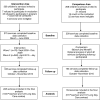Impact of a population based intervention to increase the adoption of multiple physical activity practices in centre based childcare services: a quasi experimental, effectiveness study
- PMID: 22929434
- PMCID: PMC3494551
- DOI: 10.1186/1479-5868-9-101
Impact of a population based intervention to increase the adoption of multiple physical activity practices in centre based childcare services: a quasi experimental, effectiveness study
Abstract
Background: There is considerable scope to improve the delivery of practices that increase the physical activity of children in centre based childcare services. Few studies have reported the effectiveness of interventions to address this, particularly at a population level. The primary aim of this study was to describe the impact of an intervention to increase the adoption of multiple policies and practices to promote physical activity in centre based childcare services.
Methods: A quasi experimental study was conducted in centre based childcare services (n =228) in New South Wales (NSW), Australia and involved a three month intervention to increase the adoption of eight practices within childcare services that have been suggested to promote child physical activity. Intervention strategies to support the adoption of practices included staff training, resources, incentives, follow-up support and performance monitoring and feedback. Randomly selected childcare services in the remainder of NSW acted as a comparison group (n = 164) and did not receive the intervention but may have been exposed to a concurrent NSW government healthy eating and physical activity initiative. Self reported information on physical activity policies, fundamental movement skills sessions, structured physical activity opportunities, staff involvement in active play and provision of verbal prompts to encourage physical activity, small screen recreation opportunities, sedentary time, and staff trained in physical activity were collected by telephone survey with childcare service managers at baseline and 18 months later.
Results: Compared with the comparison area, the study found significantly greater increases in the prevalence of intervention services with a written physical activity policy, with policy referring to placing limits on small screen recreation, and with staff trained in physical activity. In addition, non-significant trends towards a greater increase in the proportion of intervention services conducting daily fundamental movement skill sessions, and such services having a physical activity policy supporting physical activity training for staff were also evident.
Conclusion: The intervention was effective in improving a number of centre based childcare service policies and practices associated with promoting child physical activity. Adoption of a broader range of practices may require more intensive and prolonged intervention support.
Figures
References
-
- Cliff DP, Okely AD, Smith LM, Kim M. Relationships Between Fundamental Movement Skills and Objectively Measured Physical Activity in Preschool Children. Pediatr Exerc Sci. 2009;21(4):436–449. - PubMed
-
- Timmons BW, Naylor P-J, Pfeiffer KA. Physical activity for preschool children–how much and how? Canadian Journal of Public Health Revue Canadienne de Sante Publique. 2007;98(Suppl 2):S122–S134. - PubMed
Publication types
MeSH terms
LinkOut - more resources
Full Text Sources


